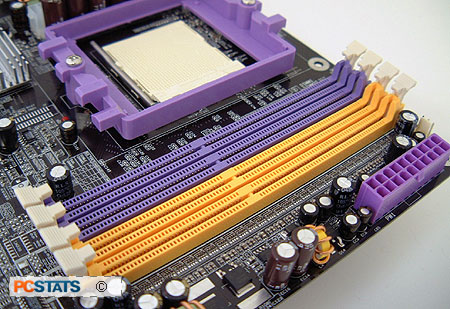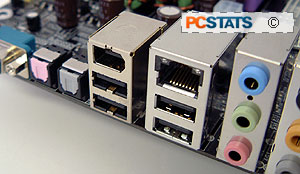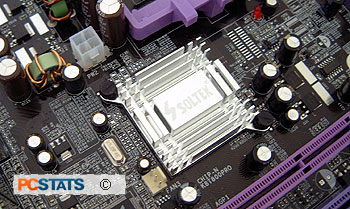The Soltek SL-K8TPro-939 comes with a fan
header just above the AGP slot next to the Northbridge, so
if you are using a 3rd party cooler it is easy to plug it
in without resorting to messy extension cables. So for example, you could replace
either the videocard cooler or Northbridge heatsink with something a bit more extreme,
and power is right there.

The other auxiliary fan header is near the bottom
right hand corner of the board, which is the typical location of the case intake
fan. Of course the third and final header is dedicated for processor cooling,
and is near the CPU socket. The 'Clear CMOS' jumper is also placed in an easily
identifiable location at
the bottom
of the motherboard where it can be access when the board is installed in
the case.
 The audio ports on the rear I/O
are unfortunately not the auto sensing type, so you'll need to plug the proper jack in its spot. That's
not hard to do though considering everything is colour coordinated. Those audio
enthusiasts out there will be very pleased that Soltek decided to equip the
board with both SPDIF In and Out ports on the back of the SL-K8TPro-939
motherboard.
The audio ports on the rear I/O
are unfortunately not the auto sensing type, so you'll need to plug the proper jack in its spot. That's
not hard to do though considering everything is colour coordinated. Those audio
enthusiasts out there will be very pleased that Soltek decided to equip the
board with both SPDIF In and Out ports on the back of the SL-K8TPro-939
motherboard.
There's not really much to complain about with this motherboard aside from
poorly labelled front panel I/O connectors. As it is, they're difficult to decipher and you'll most likely have
to connect things more than once to figure things out.
It would have been nice if Soltek threw in the
second USB header bracket, the IEEE 1394 bracket, and the LPT1 printer bracket.
This would have saved end-users the time and trouble of hunting them down as
they are not included to take advantage of the headers available. As it is, you
will not be able to use an old printer with this motherboard
without first hunting down an LPT1 header, and hopefully having a motherboard
with space for it to be mounted. We also would have liked it if Soltek had
included three rounded IDE cables instead of just one.
Overclocking Tests
 We haven't had much luck overclocking VIA K8T800 Pro based motherboards in the last
little while, and I was hoping for a bit more success with the Soltek SL-K8TPro-939. The first
thing we did was lower the multiplier to 8x so that the Athlon64 4000+ processor
clock speed would not limit our maximum motherboard overclock tests.
We haven't had much luck overclocking VIA K8T800 Pro based motherboards in the last
little while, and I was hoping for a bit more success with the Soltek SL-K8TPro-939. The first
thing we did was lower the multiplier to 8x so that the Athlon64 4000+ processor
clock speed would not limit our maximum motherboard overclock tests.
At 217 MHz, the motherboard exhibited some stability problems
and we had to raise the memory voltage to 2.8V. Instability next showed up
on the board at 224MHz and we had to increase the chipset voltage to 2.7V
to resolve that.
In the end the SL-K8TPro-939
was able to reach a maximum motherboard clock speed of 233 MHz. This is pretty good for a VIA
K8T800 Pro based motherboard. Our previous overclocking attempts with this chipset
only reached 220 MHz, so the performance of the Soltek SL-K8TPro-939 was a nice
surprise.
